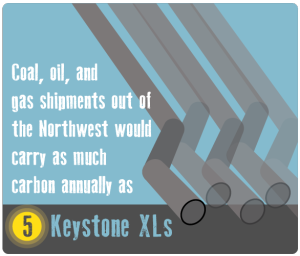For immediate release: September 9, 2014

Original Sightline Institute graphic by Don Baker Design, available under our free use policy.
A new report from Seattle-based think tank Sightline Institute finds that new coal, oil, and gas shipments planned for the Pacific Northwest would carry more carbon annually than five Keystone XLs.
The report’s author, Sightline policy director Eric de Place, calculates the carbon in active proposals across Oregon, Washington, and British Columbia including four new coal terminals, three expansions of existing terminals, two new oil pipelines, eleven oil-by-rail facilities, and six new natural gas pipelines. Together, they would convey 822 million metric tons per year (mmta) of CO2 emissions—compared with Keystone XL’s roughly 149 mmta of CO2.
“If Keystone XL is ‘game over for the climate,’ Northwest coal, oil, and gas exports are like the game never even started,” de Place says. “We’re only talking about new capacity, on top of what’s already here, and we’re not counting all the carbon emitted from extracting, processing, or moving these fuels to market. In short, the Northwest is ground zero in the climate fight.”
Recent coal export permitting decisions in the region, along with growing public opposition to oil-by-rail shipments, have garnered national attention. Would-be fossil fuel exporters are increasingly clashing with the “thin green line” of opponents in the Pacific Northwest. Major energy, rail, and shipping companies seek to convert a region known for environmental leadership into a fossil fuel export hub of global consequence. What happens in the Northwest—whether the region grants or denies permission to coal, oil, and gas companies—will profoundly impact global energy markets and even the future of the climate.
Read the full report at www.sightline.org/5KXLs.
Sightline Institute is a think tank providing leading original analysis of energy, economic, and environmental policy in the Pacific Northwest.







